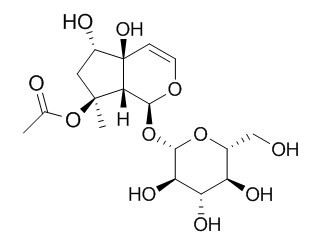6-Epi-8-O-acetylharpagide
Standard reference
Inquire / Order:
manager@chemfaces.com
Technical Inquiries:
service@chemfaces.com
Tel:
+86-27-84237783
Fax:
+86-27-84254680
Address:
1 Building, No. 83, CheCheng Rd., Wuhan Economic and Technological Development Zone, Wuhan, Hubei 430056, PRC
Providing storage is as stated on the product vial and the vial is kept tightly sealed, the product can be stored for up to
24 months(2-8C).
Wherever possible, you should prepare and use solutions on the same day. However, if you need to make up stock solutions in advance, we recommend that you store the solution as aliquots in tightly sealed vials at -20C. Generally, these will be useable for up to two weeks. Before use, and prior to opening the vial we recommend that you allow your product to equilibrate to room temperature for at least 1 hour.
Need more advice on solubility, usage and handling? Please email to: service@chemfaces.com
The packaging of the product may have turned upside down during transportation, resulting in the natural compounds adhering to the neck or cap of the vial. take the vial out of its packaging and gently shake to let the compounds fall to the bottom of the vial. for liquid products, centrifuge at 200-500 RPM to gather the liquid at the bottom of the vial. try to avoid loss or contamination during handling.
Front Immunol.2023, 14:1240800.
Journal of Mushroom2024, 22(4):192-198
J Nat Med.2022, 76(1):59-67.
Molecules.2018, 23(11):E2837
Int J Med Sci.2020, 17(5):626-631
J Korean Soc Food Sci Nutr2023, 52(12):1248-1255
J Korean Med Obes Res.2023, 23:10-7
Genes Genomics.2020, 10.1007
Journal of functional foods2018, 171-182
Applied Biological Chemistry 2021, 64(75)
Related and Featured Products
Nat Prod Commun. 2013 Mar;8(3):333-4.
Andrographidine G, a new flavone glucoside from Andrographis paniculata.[Pubmed:
23678804]
A new flavone glucoside, andrographidine G (1), was isolated from Andrographis paniculata together with 13 known compounds, including flavonoids, diterpenoids, and iridoids.
METHODS AND RESULTS:
The structure of 1 was established by spectroscopic and spectrometric techniques, including HR-ESI-TOF-MS, 1D and 2D NMR, and chemical methods. The known compounds were identified as andrographidine A (2), (2R)-5-hydroxy-7,8-dimethoxyflavanone-5-O-beta-D-glucopyranoside (3), acanthoside B (4), neoandrographiside (5), andropanoside (6), andrographiside (7), andrographolide (8), 14-deoxy-11,12-didehydroandrographiside (9), 14-deoxy-11,12-didehydroandrographolide (10), procumbide (11), procumboside (12), 6-Epi-8-O-acetylharpagide (13), and curvifloruside F (14).
Phytochemistry. 2000 Aug;54(8):807-9.
Iridoids from Caryopteris x clandonensis.[Pubmed:
11014270]
In continuation of our phytochemical studies on Caryopteris x clandonensis (Lamiaceae), three further iridoids were isolated from the methanolic extract of the stems.
METHODS AND RESULTS:
Their structures were established by 1D and 2D NMR and MS analysis as a C-6 epimer of 8-O-acetylharpagide (6-Epi-8-O-acetylharpagide), a derivative of harpagide which contained the unusual feature of a 3',4' seco-glycopyranosyl moiety (clandonoside II) and a methyl cetal of 8-O-acetylharpagide aglucone hydrate named clandonensine.



